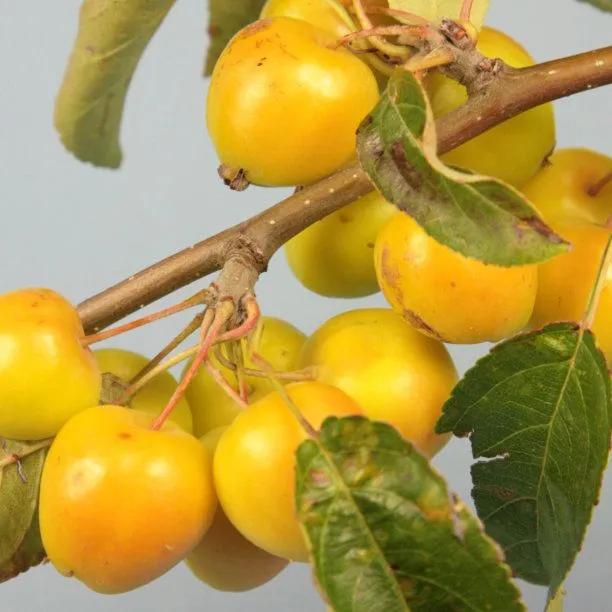Golden Hornet Crab Apple, Large Trees

The details
- Native. White-pink flowers, bright yellow fruit.
- One of the two best orchard pollinators.
- Ideal for jelly & adding to cider.
- Persistent fruits
- Max. Height: 6-7m
- Bareroot Delivery: Nov-Mar.
Recommended extras
Description
Malus Golden Hornet: Bareroot Golden Hornet Crab Apple Trees in Standard Sizes
Golden Hornet gets its name from the honey yellow crab apples, which stay on the branches well into winter. These are excellent for jelly making (which is golden) or pressing into cider, although Butterball is slightly better in that the fruit can be stored for longer before use. The flowers open in spring from bright pink buds: most will be pure white, some will keep a pink blush.
They are one of the best pollinators for apple orchards; along with the likes of John Downie, they have an especially long flowering period that covers almost all apple pollination groups. To 7 metres.
Browse our variety of crab apple trees or our full range of trees.
Delivery season: Crab apple trees are delivered bareroot during late autumn and winter, approximately November-March inclusive.
Choosing a size: Small trees are cheaper, easier to handle and more forgiving of less than ideal aftercare, so they are best for a big planting project. If instant impact is your priority, or if you are only buying a few plants for use in a place where it is convenient to water them well in their first year, then you may as well use bigger ones. All our bareroot trees are measured by their height in centimetres above the ground (the roots aren't measured).
Features:
- Height: 7m
- Soil: Any well drained
- Use: Edible fruit, small gardens, urban, large containers
- One of the two best orchard pollinators
- Ideal for jelly & adding to cider
- Colour: White flowers, touched with pink, in April-May
- Former RHS AGM holder
- Persistent fruits
- Bareroot delivery only: November-March
Growing Golden Hornet Crab Apples
Any well drained soil. Full sun is ideal if you plan to harvest the fruit, otherwise partial shade is fine. Tolerant of pollution.
If scab is a problem in your area, consider using the highly disease resistant Red Sentinel.
Planting Instructions
Notes on planting Malus Golden Hornet:
Crabapples are tough plants that thrive in any moderately fertile soil. They tolerate shade well, although we recommend planting them in full sun to get the best display of flowers and fruit. Although a moist, well drained site is ideal, crabapples like heavy clay and don't mind a bit of waterlogging in winter.
They won't grow in deep shade and may struggle in very poor dry soil.
Prepare your site before planting:
It is good to dig over the site where you plant a tree several months in advance. Kill the weeds first: for tough weeds like nettles, brambles and ground elder, you will usually need a weed-killer to get rid of them. When you dig the soil over, remove stones and other rubbish and mix in well rotted compost or manure down to the depth of about 2 spades.
Watch our video on how to plant a tree for full instructions.
Remember to water establishing trees during dry weather for at least a year after planting.
Tree Planting accessories:
Prepare your site for planting by killing the weeds and grass.
You can buy a tree planting pack with a wooden stake & rubber tie to support the tree and a mulch mat with pegs to protect the soil around the base of your tree from weeds and drying out.
We suggest that you use mycorrhizal "friendly fungi" on the roots of all newly planted large trees: if your soil quality is poor, we strongly recommend it.
You can also improve your soil with bonemeal organic fertiliser.
Did You Know?
This tree was bred in 1948 by J Waterer & Sons Nursery. The records do not survive, but the ancestors are thought to be Malus prunifolia rinki / coccinea crossed with M. sieboldii calocarpa, which led to a variety called Wintergold, of which Golden Hornet is an improved version.
It is a former RHS AGM holder; there is no easy reference source for why the award is removed, but it is usually because a slightly better and very similar cultivar receives it.
Standard trees are measured by their girth in centimetres 1 metre above ground level: their trunk's waist measurement. Unlike sapling trees and hedge plants, standards aren't measured by their height, which will vary quite a bit both between and within species.
So, a 6/8cm standard tree has a trunk with a circumference of 6-8cm and an 8/10 standard has a trunk 8-10cm around. This measurement makes no difference to the tree's final height.
On average, standard trees are 2-3.5 metres tall when they arrive, but we cannot tell you precisely how tall your trees will be before we deliver them.


